"Nothing is true; everything is permitted." We learned this adage in the original Assassin's Creed, and Assassin's Creed II carries on the tradition beautifully, inspiring you to rethink the conspiracy at the heart of the series--and to reconsider what you should expect from a sequel. The franchise's second console outing is an impressive piece of work. Developer Ubisoft Montreal has addressed almost all of Assassin's Creed's flaws by filling its follow-up with fresh and enjoyable mission types and layering on new and mostly excellent features, while still retaining the joy of movement and atmospheric wonder that characterized the original. These enhancements range from the subtle (you can swim now) to the game-changing (there's an economy), but aside from a few small missteps, every tweak makes for a more enjoyable, more engaging adventure. The cohesive story and a terrific new character will draw you in, and you aren't apt to forget the memorable and explosive ending that will have you eager for the third installment.
Like in the first game, Assassin's Creed II occurs across two timelines: a modern-day chronology starring bartender Desmond Miles, and another featuring one of Desmond's ancestors. When you start the game, you'll catch up with Desmond right where the original left him, though as fans of the original can guess, the Abstergo labs are no longer a safe haven. You'll spend a bit of time with Desmond during the course of the game, though the shoes you most frequently fill are those of Ezio Auditore da Firenze, the charmingly impetuous son of a 15th-century Italian banker. Ezio is an instantly likable firebrand, as passionate about family and honor as he is about wine and women. When you first meet him, Ezio is living a carefree life and has not yet donned his assassin's robe, nor is he familiar with the creed. However, Ezio's devil-may-care freedom is soon cut short by murder and betrayal instigated by the assassins' greatest threat: the Templars.
Assassin's Creed's Altair was an interesting character, but only for the stealthy order he represented, not because you ever got to know the man under the white hood. Ezio is far more appealing, for he's not just quick with a secret blade, but he's a fully realized protagonist. He isn't at the mercy of the plot, but rather, the narrative evolves from his need to uncover the truth behind his sorrows. It's the personal nature of the narrative that makes Assassin's Creed II's story more compelling than its predecessor's. The few modern-day segments featuring Desmond pack a lot more punch this time around as well, and the conspiracies driving that story arc become a lot clearer and, as a result, more provocative. While the original ended on a vague and unsatisfying note, the latest chapter's climax is downright electrifying.
Ezio isn't Assassin's Creed II's only headliner. The Italy he inhabits is a character in and of itself, filled with visual and sonic details that infuse the world with life and elegance. The cities you explore--Florence, Venice, and more--are larger and more detailed than the environs of the first game. Citizens go about their daily lives, and they look authentic doing so. Merchants sweep the street in front of their shops; small groups stroll along, making conversation with each other; and courtesans smirk and cajole as you pass by. These folks aren't cookie-cutter character models. They are dressed differently enough from each other and are animated so expressively that it's as if the population would go about its business with or without your presence. More impressive are the cityscapes themselves as they unfold in front of you, inviting you to take in their splendor. This is an incredibly good-looking game: the lighting is sumptuous, the draw distance is vast, and textures are crisp. The PlayStation 3 version does suffer from some frame rate jitters, more frequent texture fade-in, and lesser color saturation. Both versions are still attractive, however, and apart from a few small flaws, you rarely get the feeling that visual compromises were made to make the game's open world run smoothly.
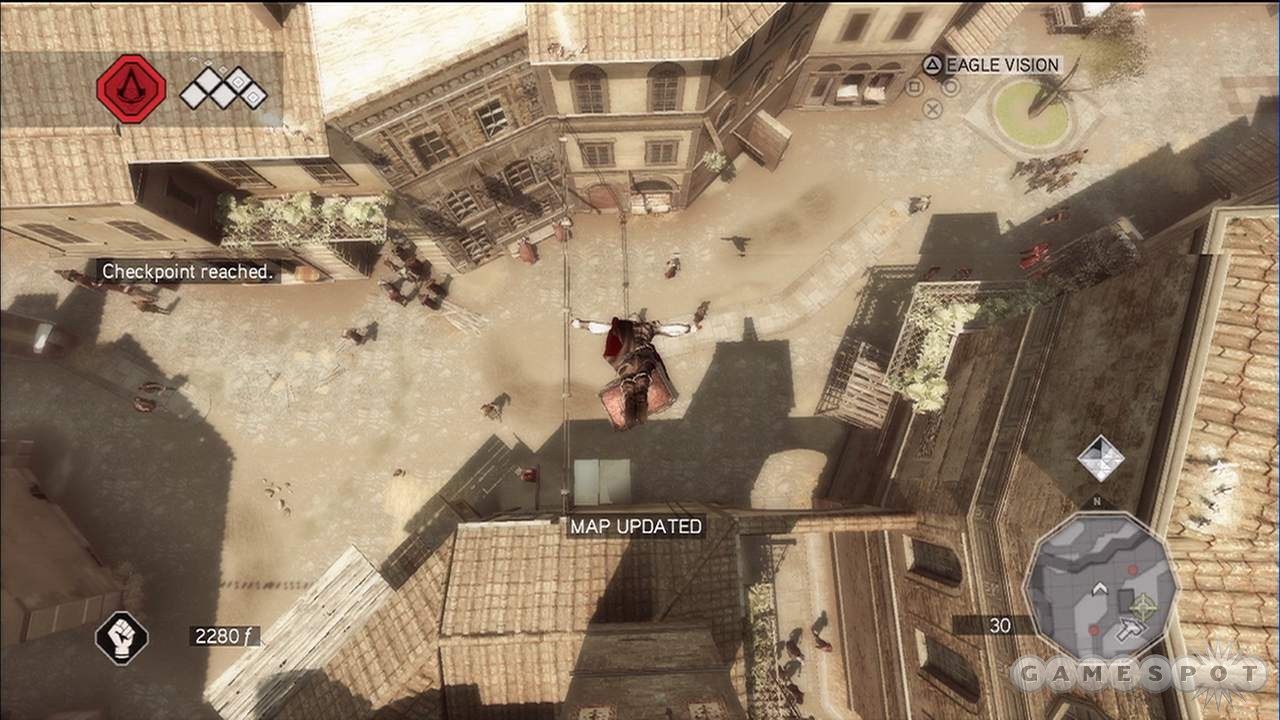
Assassin's Creed II's sense of place and time isn't due just to its visuals, however. Its high-quality sound design is equally responsible, delivering a busy-sounding Florence while still allowing the little quips of citizens commenting on your acrobatics to shine through. There's a good variety of such dialogue now, so you won't tire of repeated lines, and because the citizen rescues of the original Assassin's Creed have been excised, you won't hear the monotonous whines of complaining peasants. Two aspects of the sound design are particularly noteworthy: the music and the voice acting. The game's splendid orchestral score is subtle and soothing when it needs to be, never intruding on the exploration and never manipulating your emotions with inappropriate musical melodrama. The simple but effective cello and double bass motif you hear when climbing to a perch and synchronizing your map is the perfect example of this smart melodic restraint. As for the voice acting, it is uniformly excellent. Not only is Ezio voiced with charm and energy, but the surrounding cast is mostly superb--though one particular line delivered by Ezio's uncle Mario might make you cringe.
The greatest beauty of Assassin's Creed II's exquisitely detailed environments is that you can run and jump across the rooftops with ease and climb the tallest towers to get a bird's-eye view of the game's glorious vistas. You control Ezio much as you did Altair, though movement feels a bit tighter and even more fluid than before. The game strikes an excellent middle ground between responding to player input and automating actions like leaping from one surface to the next, so it's simple to leap about the city smoothly without worrying that you're going to plummet to your death on the next hop. You'll still encounter a few awkward moments here and there: simply walking off a ledge onto a rooftop a few feet below can still be bit clumsy, for example. But these moments are few, and in fact, you'll pull off some awesome-looking moves without even trying. One of the many wonders of Assassin's Creed II is that the cities look so natural that they don't seem as if they were created for you to jump around in. Yet you might leap onto a wooden outcropping and find yourself skipping across a series of them, swinging and jumping with fluidity and style. Not only are there more opportunities for organic platforming sequences like these than in the original, but there are entire closed environments called tombs tailored to this kind of jumping.
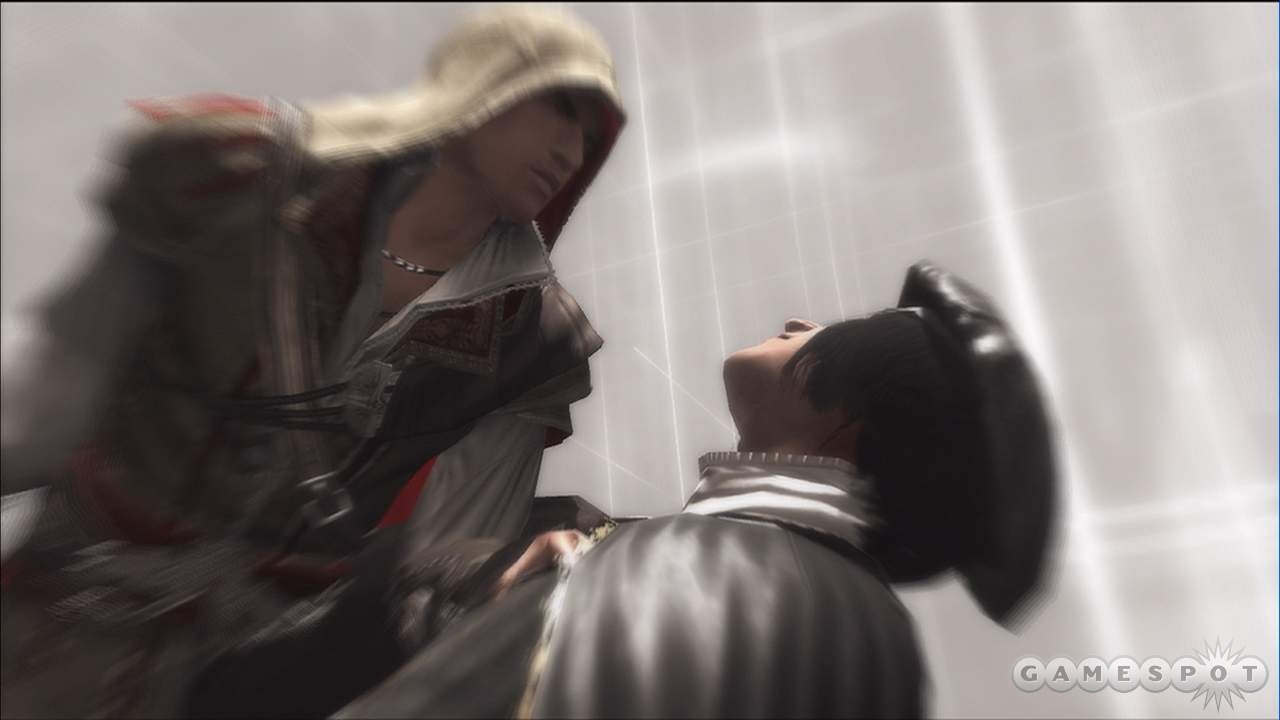
Tombs are more intricate levels in which you must retrieve an important artifact (and if you collect all of them, you are in for a special treat). Some of them are platforming puzzles of the best kind, in which you must figure out how to get from your starting point to the destination, in the manner of Prince of Persia: The Sands of Time. Ezio can't run on walls like the Persian prince, but he's incredibly agile nonetheless, and swinging and hopping about rafters and chandeliers within the tombs is great fun. A few tombs throw some additional challenges at you, such as a time limit in which to reach your goal. The best tombs, however, are those in which you pursue an enemy but run into obstacles that force you to give chase using an alternate route. The chases are excellent, and they require quick reactions, but not so quick as to be unreasonable. Flawlessly keeping up with your target without breaking your momentum is one of Assassin's Creed II's greatest thrills, and as long as you are paying close attention, you can pull it off on the first attempt.
The climbing and jumping wouldn't be as rewarding if Ezio weren't so graceful, but he is one of the best-animated characters yet seen in a game. You'll admire his footwork early in the game in particular, when his assassin's garb does not veil the incredible animations of his legs and feet. When Ezio climbs, his hands are grabbing something and his feet are resting on something. Except on rare occasions, you won't see him pulling himself up using an invisible handle or stepping on a nonexistent ledge. It's a small touch, but it goes a long way toward making these acrobatics look believable. Ezio seems even more nimble than Altair; his legs move inward and cross a bit differently during a climb, and moves connect even more slickly. The only imperfection you are likely to notice is the lack of a transition animation when you bend to loot a body or treasure chest (more on this to come).
Of course, Ezio is more than just a talented gymnast without a fear of heights. He's not afraid to shed blood when the time is right, and he's got a number of ways to exact revenge. The dual hidden blades are his best deadly toy in this regard. You can still stealthily pull off a low-profile assassination (sneak up behind a guard and stab him in the neck) or conduct a high-profile kill (pounce on your target and plunge your blade into him in a single, dramatic move). But the best addition to hidden blade kills are double assassinations: Walk between two unsuspecting guards, sink a blade into each of them, watch them crumple to the ground, and keep walking as if you were none the wiser. If you get really enamored with the dual blades, you can hang from a ledge and wait for an enemy to walk above you, stab him, and toss him to the ground below. It's particularly satisfying to do so above the Venetian canals, because the body will splash into the water and then float to the top. Or if you'd rather conduct your bloody business from above rather than below, you can wait for your target to walk below and then assassinate him in one spectacular move.
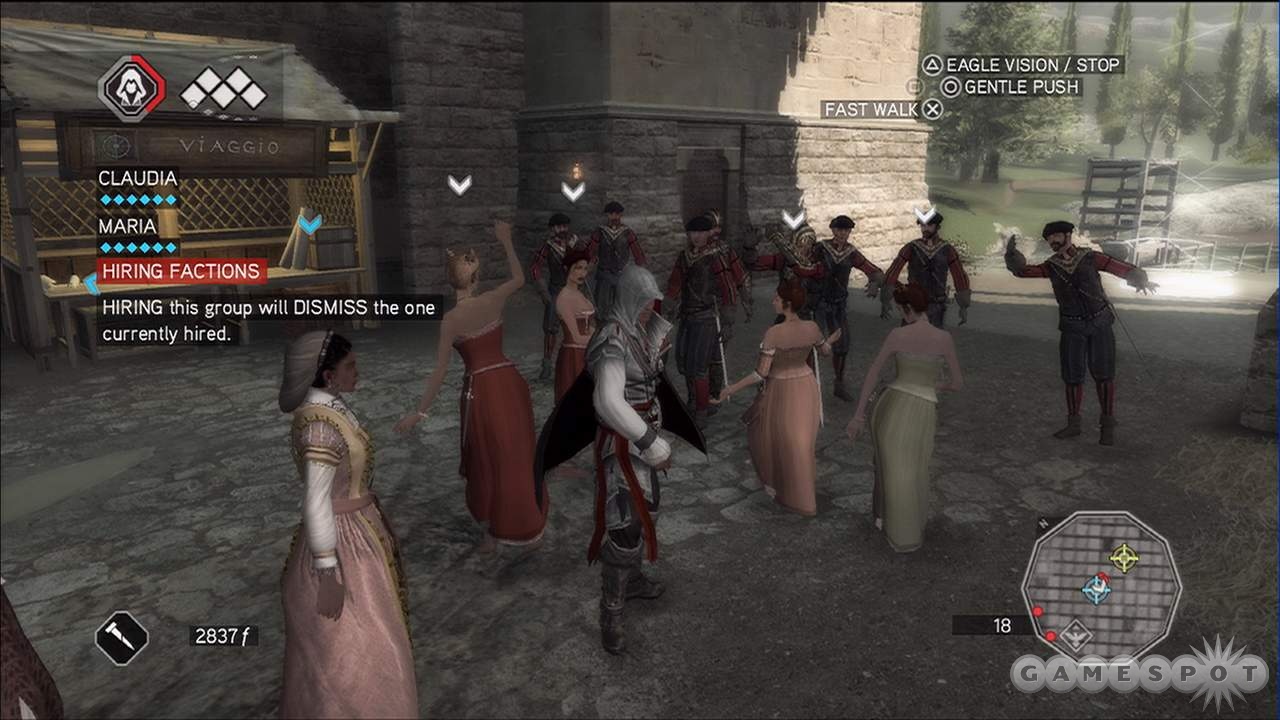
If you want to take the direct approach instead, you've got more to unsheathe than a basic sword. One of your brand-new combat moves is the ability to disarm an opponent and take his weapon. For a treat, try taking a giant axe from one of the heavily armored guards and planting it in his head, or skewering another with a stolen spear. If you like, however, you can stick with what you've got and simply pick up your fallen foe's weapon off the ground once the skirmish is done. As before, you can toss throwing knives at pesky archers, but Assassin's Creed II also gifts you with a special ranged powerhouse late in the game. Or perhaps you like to play with your victim before it's time to recite the requiem. If so, stab him with your poison blade and watch him stumble about as he tries to gain his bearings before you slice his throat. If that weren't enough, you can purchase improved weapons and armor pieces from blacksmiths scattered around the cities. By the time you are finished, Ezio may be decked out in some impressive-looking gear--and sporting some highly effective weaponry. The essentials of combat remain the same throughout, however: When battle is initiated, you lock onto targets, dance about each other looking for an opening, and time counter moves to pull off a bloody and satisfying kill. Combat isn't difficult, but the addition of larger-scale battles makes it more exciting in this outing. Nevertheless, it's disappointing that enemies still dutifully wait their turn to attack.
Blacksmiths aren't the only vendors willing to take your cash. Assassin's Creed II sports an entire economy. You earn florins by completing missions, looting treasure chests, pickpocketing strangers, or stealing from dead bodies and covered Venetian gondolas. Your main source of income, however, will likely be your uncle's villa, which serves as your base of operations and is a tourist destination. The adage "You have to spend money to make money" is true. You can spend florins on villa upgrades, such as purchasing a brothel or a church, and in turn, the villa will earn more florins from tourists, and you can take the profits from a chest inside the living quarters. You can then use your florins to dye your garb, purchase treasure maps to point out the locations of all those glowing chests, or buy a new pouch to hold more throwing knives. Most importantly, you'll want to visit a doctor, who not only will inform you that a weekly bleeding is part of a healthy lifestyle (yuck), but will keep you stocked in health packs. That's right: Your health does not replenish on its own any longer, so you'll need to make occasional visits to the doctor to replenish your inventory.
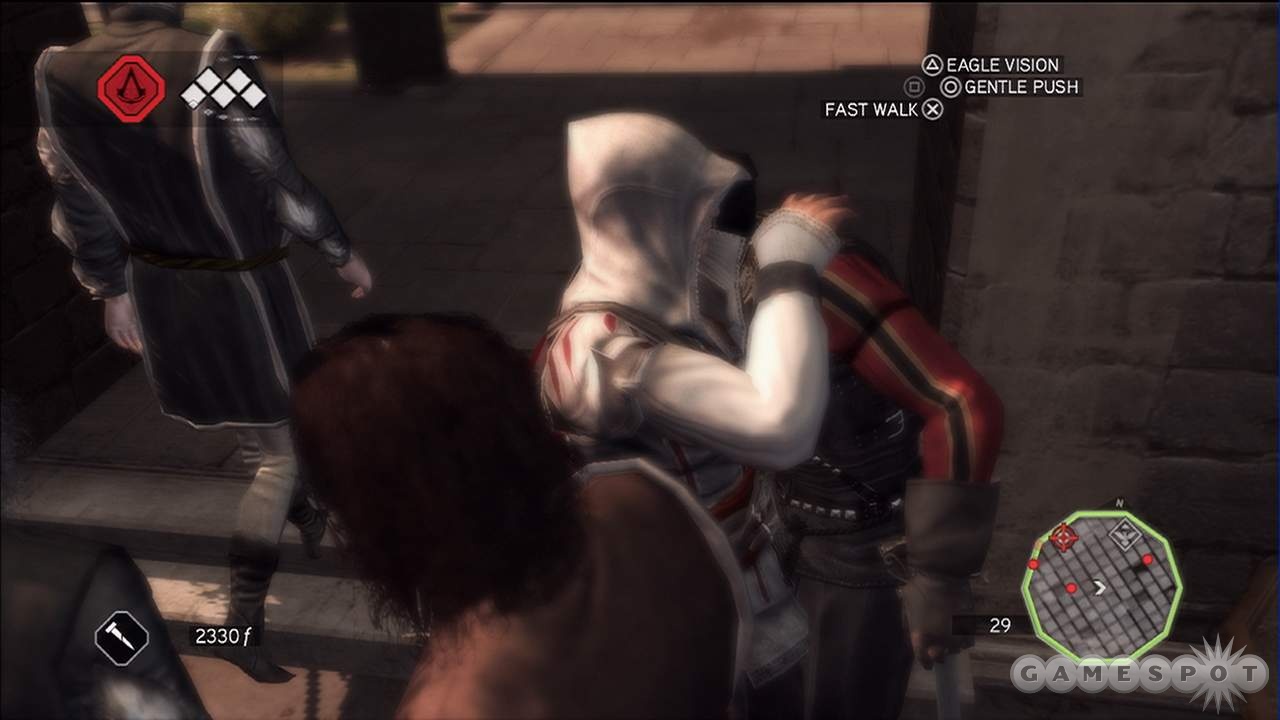
If you'd rather just avoid physical damage altogether, you can still keep a low profile, and there are many improvements in this regard as well. You've still got a few old tricks to rely on: benches to sit on and haystacks to hide in, for example. But contrivances of the original (remember Assassin's Creed's scholars, and walking at a snail's pace in prayer?) have been replaced by more natural and sensible mechanics. If you want to blend with the crowds, you can walk into a group of citizens and be automatically hidden. It's fun to move smoothly from one roving group to another and avoid the watchful eye of nearby guards, though there are sadly few occasions when doing so is essential. Or you can slink past guards by hiring a group of courtesans to distract them with their feminine wiles, or by hiring a group of thieves to engage them. You can even throw smoke bombs and use the resulting cover to sneak past. You can still fight your way through most situations, but there's something uniquely satisfying about taking the stealthy approach.
Yet even if you don't often need to be sneaky if you don't wish to be, you'll still need to stay out of the public eye if you can by keeping your notoriety levels low. Notoriety works much as it does in the Hitman games: The more bad deeds you're caught doing, the higher your notoriety levels rise, and the more likely it is that guards will recognize you. If you want to roam the city without worrying about being chased by every group of guards you pass, you can reduce or eliminate your level of notoriety by bribing town criers or by assassinating key guards. The easiest way to reduce your notoriety, however, is to remove the "Wanted" posters that appear whenever your notoriety meter begins to fill. This is one of Assassin's Creed II's more artificial elements, simply because "Wanted" posters appear in places that no guard would ever see. Nevertheless, "Wanted" posters give you another reason to clamber to the rooftops, which is never a bad thing.
The story missions tying all of this exploration and combat together are vastly improved over those of the original, often stringing multiple objectives together and usually making good use of Ezio's skills. Eavesdropping missions are gone completely, and beat-'em-up tasks are mostly optional. Instead, you will be rescuing prisoners, tailing important targets from the rooftops, assassinating wrongdoers, and plenty more. Some of the best missions act as set pieces and often involve Ezio's ever-positive friend, the resourceful Leonardo da Vinci, who will not only upgrade your synchronization (health) bar, but provide you with a few amusing gadgets, like your poison blade and smoke bombs. In one exciting scene featuring your talented comrade, you drive a horse-drawn carriage at a breakneck pace. In another, you take to the skies in one of da Vinci's flying contraptions, using the heat rising from the city's chimneys to stay aloft while kicking archers out of the way. If you thought Assassin's Creed lacked variety, you'll find plenty in the sequel.
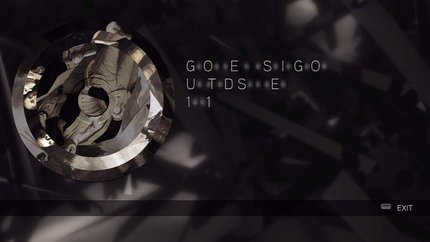
Optional tasks are compelling as well. You can still climb to the tops of towers and make a leap of faith into a bale of hay or autumn leaves beneath, and doing so is just as unrealistic and awesome as it ever was. The flags of the original have been replaced by feathers, which tie in to story events early in the game. New missions include assassination assignments retrieved from messenger pigeons and timed rooftop races, which are always enjoyable in a game that makes the simple act of moving from one location to the next such a pleasure. You also run the risk of being pickpocketed, in which case you can chase after the perpetrator and tackle him, pilfering not just your stolen funds, but the florins of other victims as well. Another intriguing addition is the hidden glyphs you locate on certain buildings by activating your eagle vision. These glyphs tie the story's dual timelines together in an intriguing way and initiate puzzle sequences that in turn unlock short video snippets. The puzzles aren't that great, but the snippets are so weirdly fascinating that you'll want to collect all of them so that you can watch them in sequence. There are enough historical and religious conspiracy tidbits in here to keep you interested, and they're just outrageous enough to delight Dan Brown devotees.
At first, Assassin's Creed II might seem as if it has added more than its foundation was meant to handle, but once all the new features are completely introduced, it develops that magic that so few games can cast. This is the rare sequel that offers fans of the original the basics they would expect, while adding and changing so many other aspects that even those who didn't appreciate the first should take the plunge, without hesitation. A few more contrivances notwithstanding, Assassin's Creed II is a better game than its forebear and is a beautiful and memorable experience on its own terms. But it's more than just a game--it's an escape to a place and a time that feel so welcoming, you'll be making return trips even after your initial adventure is over.



